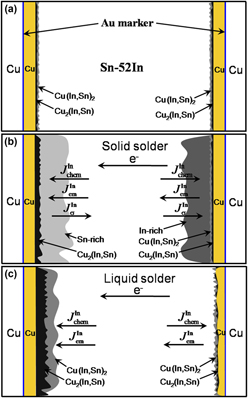Article contents
Migration behavior of indium atoms in Cu/Sn–52In/Cu interconnects during electromigration
Published online by Cambridge University Press: 21 September 2015
Abstract

The interfacial reactions in Cu/Sn–52In/Cu interconnects during solid–solid (S–S) and liquid–solid (L–S) electromigration (EM) under a current density of 2.0 × 104 A/cm2 at 90 and 150 °C have been in situ studied using synchrotron radiation real-time imaging technology. The In atoms directionally migrate toward the cathode due to the back-stress induced by the preferential migration of the Sn atoms over the In atoms toward the anode during the S–S EM, resulting in the segregation of the Sn and In atoms at the anode and cathode, respectively. During the L–S EM, however, the In atoms directionally migrate toward the anode due to the negative effective charge number (Z*) of In rather than the back-stress. The polarity effect, i.e., the intermetallic compounds growing continuously at the anode while becoming thinner at the cathode, is more significant during the L–S EM than the S–S EM. Furthermore, the consumption rate of the cathode Cu during the L–S EM is three orders of magnitude higher than that in the case of the S–S EM because of the significantly higher EM-induced atomic flux in the liquid solder. The migrations of the Sn, In, and Cu atoms are discussed in terms of diffusion flux.
- Type
- Articles
- Information
- Copyright
- Copyright © Materials Research Society 2015
Footnotes
Contributing Editor: C. Robert Kao
References
REFERENCES
- 10
- Cited by


